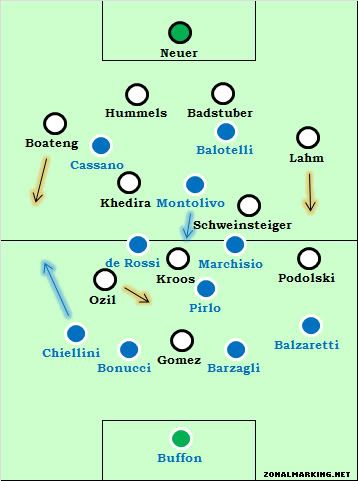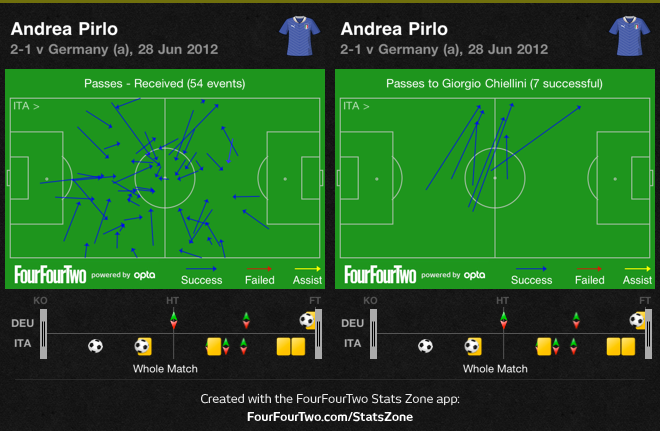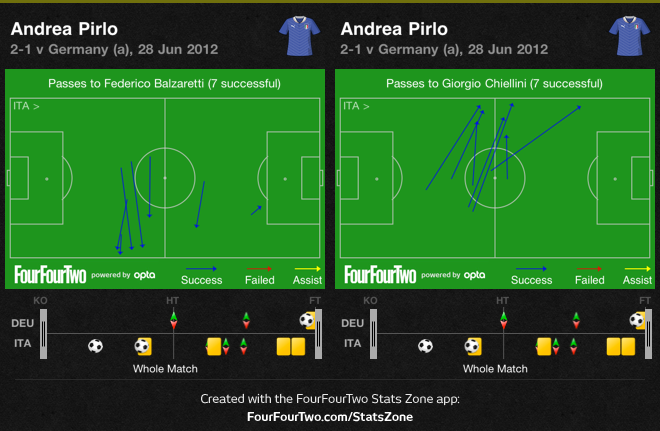|
|
本帖最后由 Alex2011 于 2012-6-29 14:34 编辑
Italy 2-1 Germany: Balotelli double
June 29, 2012

The line-ups for most of the first half, after Ozil and Kroos switched early on
Jogi Low tried to change his shape to compete in the centre of midfield, but Italy produced an excellent performance to qualify for the final.
Cesare Prandelli kept his diamond system. Giorgio Chiellini returned at left-back, but Ignazio Abate was unfit, so Federico Balzaretti moved over to an unfamiliar right-back role.
Jogi Low had decisions to make in his front four, with only Mesut Ozil sure of his place. Mario Gomez was chosen ahead of Miroslav Klose, and Lukas Podolski was selected rather than Andre Schurrle. But the real surprise was in the other role, as Toni Kroos came into the side.
That was an attempt to deal with Italy’s midfield diamond, but Germany didn’t have the right structure in the centre of the pitch and were disappointing for long periods.
Ozil / Kroos
The use of Kroos was a big surprise, though it wasn’t an illogical decision. Italy’s clear area of strength was the centre of their midfield, where they use four very fine passers. Germany only play with two men in that zone, with Ozil much higher up, so when the teamsheets were unveiled and Kroos was in Germany’s XI, it was widely expected that he’d be a third central midfielder, allowing Germany to battle in that zone, with Ozil on the right.
From the start of the game, however, it was the other way around. Ozil played in his usual central position, Kroos was on the right. After around eight minutes, they switched. Was this a deliberate tactic from Low, to trick Prandelli into thinking Germany were playing a different way? Did he suddenly get concerned that Ozil wouldn’t be able to pick up Andrea Pirlo? Or had he told Kroos and Ozil to rotate, and that was simply how things turned out?
Whatever the true story, Germany ended up with Kroos in the centre of the pitch – broadly picking up Pirlo. Ozil took up a position on the right but drifted inside onto his left foot quickly.
Problems
This gave Germany two problems. First, Kroos didn’t do a particularly good job on Pirlo. It wasn’t as bad as Wayne Rooney’s performance on Sunday, because Kroos at least spent much of his time goalside of Pirlo. But he constantly didn’t put enough pressure on and dropped too deep. That would later be a factor for Italy’s first goal, as the move stemmed from a long Pirlo diagonal, and though he wasn’t as pivotal as against England (naturally, as Italy had less of the ball), he was still the key midfielder. Daniele De Rossi did a good job alongside him, covering when Pirlo moved forward.
Second, Germany didn’t attack with enough width – which was strange as Italy’s full-backs had no protection from ahead because of Italy’s narrow shape in midfield. Furthermore, both Chiellini and Balzaretti were playing away from their normal positions (Chiellini can play left-back, but is more renowned as a centre-back), so these were the players Germany should have attacked, but both got away without much of a test.
You can understand what Low was thinking – he wanted a third central midfielder and couldn’t drop Ozil so had to play him wide. This meant he could compete against a diamond with four central players within the natural 4-2-3-1 (a slightly obscure link would be the way Manchester United outplayed (but lost to) Chelsea at Stamford Bridge three years ago) then have natural width on the other side, with the use of Podolski. But even Podolski was dragged into the midfield battle without the ball – Balzaretti barely went forward and wasn’t a threat – and Podolski had little attacking impact on the game.
But Germany did enjoy a decent opening, and created a couple of good opportunities. A couple of times they found space either side of Pirlo to have long-range attempts, but like other matches this tournament – Portugal 3-2 Denmark, Spain 2-0 France, Portugal 0-0 Spain – the movement came primarily from one side of the pitch – Germany’s right, Italy’s left.
Germany right / Italy left
This was a complex situation. Italy didn’t have anyone on that side because of the diamond, while Ozil moved inside quickly into central playmaking positions. That meant both the full-backs had space to exploit, but both did so only sporadically. Jerome Boateng was troubled by the movement of Antonio Cassano into the channels, but on two occasions he overlapped swiftly, was unmarked, and provided dangerous crosses. The first nearly produced a calamitous own goal.
Chiellini attacked less frequently, and because of his natural tendencies as a centre-back, plus the movement of Ozil, he often got dragged narrow next to his centre-backs. But when he did attack, no-one picked him up. Ozil didn’t seem to have any defensive responsibilities, and when Chiellini got forward early on, it was Boateng who came out to meet him.
The first Italian goal showed the two major things Germany were getting wrong – first, despite the initial pressure from Ozil, he drops off Pirlo and allows him time to play a long pass to the flanks. Second, because Ozil is in the centre, Kroos presumably should have been on the right (or at least in a right-centre position, where he could shuttle over towards Chiellini). Instead, Chiellini is completely unmarked. This forces Boateng out, which in turn allows Cassano space and brings Mats Hummels out, and then after a brilliant turn and cross from Cassano, Balotelli overpowers Holger Badstuber, left isolated in the middle, and heads in.
The goal could have been prevented along the way with better defending, but it seemed from Germany abandoning the right flank and allowing Chiellini space. That was only acceptable if they were competing in the middle and not allowing Pirlo space.

1-0
Another interesting feature was the positioning of the two defences. Italy kept a high line, pushing Mario Gomez away from goal. Germany played deeper than usual, probably as they were afraid of Balotelli’s pace, having seen how he got a couple of chances from long balls over the top against England. This changed after Italy went ahead, as Germany were forced to push forward, and Italy sat back.
Italy shifted to a slightly more defensive system at 1-0 up. The forwards played wider and deeper, often drifting into zones that made the German full-backs nervous about getting forward, for fear they should be picking them up. Most impressive was the role of Riccardo Montolivo – he constantly chased high up the pitch and disturbed Germany’s passing rhythm in midfield. Often he conceded free-kicks, but the spoiling job was done, and he could then shuttle back into a deeper position to join Pirlo. Sometimes, Italy’s midfield looked more like a flat four when defending, especially when the ball was wide.

Montolivo’s main contribution was in attack, though – with a tremendous ball over the top for Balotelli’s second goal, after Italy had kept two strikers high up the pitch when defending a corner. Germany’s three should have been able to cope, though.
Second half
Italy were firmly in control, and Low needed to make dramatic changes. He did – Klose replaced Gomez, while Marco Reus replaced Podolski, and went to the right. Ozil was in the centre, and Toni Kroos started on the left and moved inside into the middle, safe in the knowledge that Balzaretti wasn’t attacking much.
Germany had a good spell of pressure for the first 15 minutes of the second half, producing a couple of chances – one fell to Philipp Lahm, who moved forward well from the left-back position, with no direct opponent.
Italy subs
But Prandelli used his bench very wisely. He replaced Montolivo, who had covered a lot of ground, and introduced Thiago Motta as a more defensive option. He then withdrew Cassano and brought on Alessandro Diamanti, who played much deeper and was constantly in a position to link the play and retain possession. The introduction of Antonio Di Natale for Balotelli was another good move, as the Udinese striker was a threat on the break and should have scored a third.
In fact, Italy had plenty of opportunities on the counter-attack, probably more than Germany produced in the second half. Some wasteful finishing prevented them from extending their lead, but Prandelli’s substitutions helped stop Germany having such long spells of pressure, and gave Italy fresh legs to attack.
Low’s final move was Thomas Muller replacing Boateng, who wasn’t attacking enough from right-back. This was the last roll of the dice – Bastian Schweinsteiger ended up playing as a makeshift right-back, Khedira was the sole central player, and Muller joined Kroos, Ozil, Reus and Klose in attack. This didn’t really work – Low had to gamble, but Germany had little structure to attack within, and were shambolic in their attempts to press and win the ball quickly. A late penalty gave them hope, but Italy merited their victory.
Conclusion
Did Low adapt his side too much? Or not enough? Having spoken of the need for Germany to play their own game, it was a surprise to see Kroos in the starting line-up. But from there, Germany didn’t have a clear plan to stop Italy in the midfield zone; Pirlo wasn’t picked up effectively, while Montolivo and De Rossi also had excellent games. Germany didn’t play to their strengths, nor nullify Italy’s.
Italy’s goals were well-worked and expertly finished, but the most impressive part of their display was the defensive side of things. The defence kept a high line in the first half, then defended well inside the box when Germany piled on the pressure. Montolivo’s role was also crucial in stopping Germany building attacks from deep.
Tactically the game will be remembered for Low’s tinkering, rather than Prandelli’s instructions. That’s a shame, as this was Italy’s best performance at this tournament by a distance – previously they’d failed to beat anyone aside from an Ireland side already eliminated, but here they conclusively defeated a very strong side. Having performed well against Spain with a 3-5-2 system in their opening game, Prandelli must now decide whether to stick with the diamond for the final. |
|

